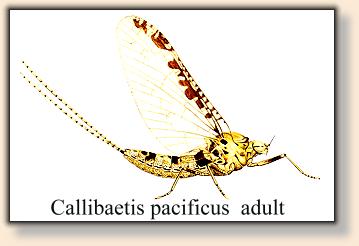 Callibaetis are another mayfly. Just as 'blue-winged olives' are mayflies, this is just
another specie. For general information of the Baetis group, check out the previous
Blue-Winged Olive article here.
Callibaetis are another mayfly. Just as 'blue-winged olives' are mayflies, this is just
another specie. For general information of the Baetis group, check out the previous
Blue-Winged Olive article here.
In the eastern United States these are mostly lake and pond dwellers, but in the cold
waters of the west, this is an important hatch. Locally called the Speckled Dun and
Spinner the insect is easily identifiable because of the speckled or 'freckled' look of
both the body and the wings.
The emergence of callibaetis fluctuans is spring, May 15th to June 20.
The western species, coloradensis from June 20th to Sept. 30,
For the black-bodied nitritus, also a western insect, it
is much longer, May 1st through Nov. 15th. The others important to fly fishers,
americanus and pallidus are July 20 to Aug. 10
and Aug. 20 to Sept. 15th for the later.

Nymphs are small to medium in size, generally size 16 hook or smaller, have
three tails of equal length, and rather large heart-shaped gills. To tie a nymph,
use a prince nymph pattern, in brown or dark brown and pick out the dubbing
well to represent the large gill structure. Wings of the adult female have brown
markings on the leading edge, and both sexes have two tails.
For the dry, called the Speckled Spinner, tie on a #14 or 16 hook, with a slate or
tan body. Swisher and Richards in Selective Trout include the
Speckled Spinner (coloradensis) as one the their "Super Hatches."

Callibaetis pacificus, shown above, known as the Medium
Specklewinged Quill and the Cream Hen Spinner, is found in ponds, lakes,
and slower waters in the western and central states. Size is as for the Speckled
Spinner, #14 - 16. It should be fished along lake margins and ponds
thoughout the summer and early fall. The illustration above is a male, easily
distinguished by the large 'stalk' type eyes. All baetis males have this type of
eye structure!
Once you have mastered the basics of tying (or choosing) a fly to match a
particular mayfly, you will realize it doesn't have to be a huge mystery. Match
the basic color and size of the insect. If you really think about it, maybe that's
why the Adams works so well! Just match the size, and the impression
of the proper insect for either mayfly or caddis is there.
Mayflies are generally easy to identify - watch for the upright wing on the dun,
which will be cloudy, the clear upright wing for the spinner (while on the water after
mating it may be totally spent winged - that is one or both wings flat on the water.)
These insects, all mayflies are pure joy for dry-fly fishers. Work on your casting and
presentation and have some fun with dry flies! ~ DLB
For more on tying methods for Mayflies, see March Brown, and see Al Campbells Fan Tailed Gray Dun, in the Beginning Fly Tying series.
Credits: Callibaetis pacificus illustration from
Aquatic Entomology by W. Patrick McCafferty, published
by Jones and Barlett, Remaining photographs from Hatches II
by Al Caucci & Bob Nastasi, published by Lyons and Burford. We
thank Al Caucci for use permission
|




